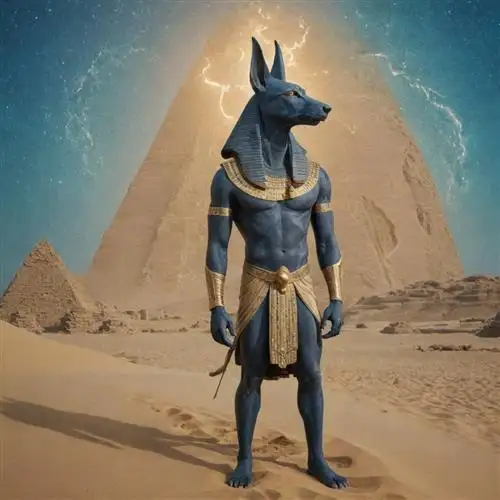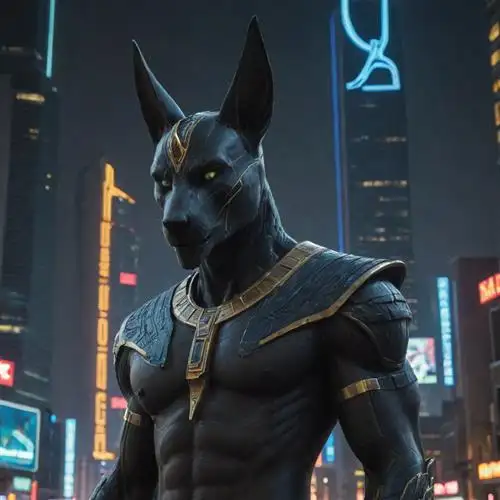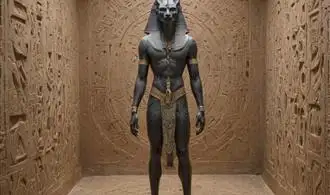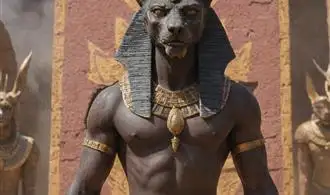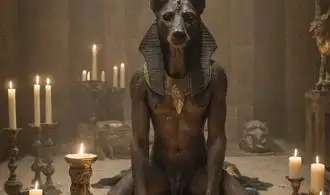
The Emergence of Anubis
The Emergence of Anubis is a captivating tale that delves into the intricate origins of one of the most iconic ancient Egyptian deities. Anubis, the jackal-headed god, has long been a central figure in the rich tapestry of Egyptian mythology, and his emergence as a divine entity is a story worth exploring in depth.
Anubis' roots can be traced back to the predynastic period of ancient Egypt, a time when the region was still a collection of distinct cultural and political entities. During this era, the jackal was revered as a sacred animal, and its association with the realm of the dead began to take shape. As Egyptian civilization evolved, the jackal's role in the afterlife became increasingly significant, eventually leading to the personification of this animal as a distinct deity.
The earliest known depictions of Anubis date back to the First Dynasty, around 3100 BC, where he was primarily associated with the embalming and burial practices of the deceased. As the god of the dead, Anubis was responsible for guiding the souls of the departed to the afterlife, ensuring a safe passage through the perilous realms of the underworld. This crucial role made Anubis a vital figure in the Egyptian funerary rites, as he was believed to oversee the process of mummification and the protection of the dead.
The emergence of Anubis as a distinct deity was further solidified during the Old Kingdom, a period marked by the construction of the iconic pyramids. During this time, Anubis became closely associated with the royal burial rituals, cementing his status as a guardian of the deceased pharaohs. The jackal-headed god was often depicted standing guard over the sarcophagi or guiding the souls of the departed through the underworld.
As the Egyptian civilization continued to evolve, the cult of Anubis grew in significance, with the god becoming a central figure in the pantheon of deities. His role expanded to include not only the protection of the dead but also the judgment of the souls in the afterlife. In this capacity, Anubis was often depicted weighing the heart of the deceased against the feather of truth, a crucial step in the process of determining the fate of the soul.
The Things You Didn't Know About the Iconography of Anubis article delves deeper into the symbolic representations and visual depictions of Anubis, further enhancing our understanding of this enigmatic deity.
The Significance of Anubis in Ancient Egyptian Mythology
Anubis, the jackal-headed deity, played a crucial role in the rich and complex mythology of ancient Egypt. As the god associated with mummification and the afterlife, Anubis held immense significance in the religious beliefs and funerary practices of the ancient Egyptians.
One of the primary responsibilities of Anubis was the important task of embalming and preparing the deceased for their journey into the afterlife. Anubis was believed to oversee the entire mummification process, ensuring that the body was properly preserved and ready for the transition to the next world. This made him a central figure in the funerary rituals and the ensuring of a successful passage for the deceased.
Additionally, Anubis was believed to be the guardian of the dead, responsible for leading the souls of the deceased into the underworld and protecting them during their journey. In this capacity, Anubis was often depicted as guiding the deceased through the dangerous and treacherous realm of the afterlife, ensuring their safe passage to the final judgment.
The role of Anubis in the judgment of the dead was also of great importance. He was believed to be present during the weighing of the heart ceremony, where the heart of the deceased was weighed against the feather of truth. If the heart was found to be pure and free of sin, the individual was granted access to the afterlife. Anubis played a crucial role in this process, ensuring the fairness and accuracy of the judgment.
Furthermore, Anubis was associated with the protection of the dead and the embalming process. He was often depicted as guarding the tombs and the mummies of the deceased, ensuring that they remained undisturbed and protected from harm. This made Anubis a vital figure in the preservation of the dead and the sanctity of their resting places.
The Evolving Portrayal of Anubis Through the Ages
Anubis, the jackal-headed Egyptian deity, has captivated the imaginations of people across the globe for millennia. As one of the most prominent figures in ancient Egyptian mythology, Anubis's representation and symbolism have evolved significantly over the course of history. From his earliest depictions as a guardian of the dead to his modern-day portrayal as a mysterious and enigmatic figure, Anubis's evolving persona reflects the rich tapestry of ancient Egyptian culture and its enduring influence.
In the earliest periods of ancient Egyptian civilization, Anubis was primarily associated with the embalming and mummification process, serving as the patron deity of the necropolis and the protector of the dead. Statues and wall carvings from this era often depicted Anubis as a jackal-headed figure, symbolizing his close connection to the canine species and their natural ability to detect the scent of death. This early portrayal of Anubis emphasized his role as the gatekeeper to the afterlife, guiding the deceased through the perilous journey and ensuring their successful transition to the next world.
As ancient Egyptian religious and funerary practices developed over time, Anubis's role and symbolism expanded. During the New Kingdom period, Anubis became closely associated with the embalming and mummification process, overseeing the meticulous preparations of the deceased for their journey to the afterlife. In this capacity, Anubis was often depicted standing guard over the embalming table, ensuring the proper preservation of the body and the soul. Additionally, Anubis was believed to weigh the hearts of the deceased against the feather of truth, determining their worthiness to pass into the afterlife.
The later periods of ancient Egyptian history saw a shift in the portrayal of Anubis, as he became increasingly integrated into the broader pantheon of Egyptian deities. While maintaining his role as the guardian of the dead, Anubis also began to be associated with other aspects of Egyptian mythology, such as his connection to the sun god Ra and his role in the Osirian cycle. This evolution of Anubis's symbolism and representation reflects the dynamic nature of ancient Egyptian religious and cultural beliefs, as the deity adapted to changing societal needs and the evolving understanding of the afterlife.
The Cult of Anubis and Its Rituals
The cult of Anubis, the jackal-headed Egyptian god of the dead, was a central component of ancient Egyptian religion and funerary practices. Anubis was responsible for the embalming and preparation of the deceased for the afterlife, making him a figure of crucial importance in the Egyptian worldview. The rituals associated with the cult of Anubis were intricate and steeped in symbolism, reflecting the deep reverence and respect the ancient Egyptians held for this powerful deity.
At the heart of the cult's rituals was the mummification process, which Anubis was believed to oversee. Embalmers would carefully remove the organs, fill the body with natron, and wrap the deceased in linen bandages, all while invoking the name of Anubis. This meticulous procedure was seen as a necessary step to ensure the preservation of the body, which was essential for the soul's journey into the afterlife.
During the funeral rites, the body would be placed on a funerary bed, and the priests would perform a series of rituals and recitations to ensure the deceased's safe passage to the afterlife. The "Opening of the Mouth" ceremony, for instance, was believed to restore the senses of the deceased, allowing them to see, hear, and speak in the afterlife. Anubis would be called upon to guide the soul through the various challenges and obstacles it would face in the afterworld.
The imagery and symbolism associated with Anubis were also an integral part of the cult's rituals. Statues and amulets depicting the jackal-headed god were often placed in tombs and used in funerary ceremonies. The black color of Anubis, which was associated with the fertile soil of the Nile, was believed to symbolize the regeneration and rebirth of the soul in the afterlife.
Additionally, the cult of Anubis was closely linked to the judgement of the dead, a crucial aspect of Egyptian theology. Anubis was believed to weigh the heart of the deceased against the feather of truth, determining their worthiness to enter the afterlife. This ritual, known as the "Weighing of the Heart," was a central focus of the cult's beliefs and practices.
The Enduring Legacy of Anubis in Modern Times
Anubis, the ancient Egyptian god associated with mummification and the afterlife, continues to captivate the modern imagination. Despite the passage of millennia, this enigmatic deity's influence can be seen in various facets of contemporary culture, from art and literature to popular media and esoteric practices.
In the realm of art, Anubis has inspired countless depictions, from the classical renderings of the Egyptian dynasties to the surreal interpretations of modern artists. The god's distinct canine features and his role as the guide of souls have made him a recurring motif in works that explore themes of mortality, transition, and the mysteries of the underworld. Renowned artists, such as Salvador Dalí and H.R. Giger, have incorporated Anubis into their visionary creations, further cementing the deity's place in the collective artistic consciousness.
The literary world has also embraced the enduring fascination with Anubis. From ancient hieroglyphic texts and the writings of classical scholars to contemporary novels and short stories, the god's presence can be felt in a diverse range of literary works. Authors have woven Anubis into narratives that delve into the complexities of death, the afterlife, and the human condition, often using the deity as a symbol of transformation and the journey of the soul.
In the realm of popular media, Anubis has found a prominent place, particularly in the realms of film, television, and video games. The god's striking appearance and mythological significance have made him a recurring figure in productions that explore ancient Egyptian themes or the supernatural. From the iconic depiction of Anubis in the "The Mummy" franchise to his appearance in acclaimed video game series like "Assassin's Creed," the deity's influence continues to captivate modern audiences and shape their understanding of ancient Egyptian mythology.
Beyond the realms of art, literature, and popular culture, Anubis has also found a home in esoteric and spiritual practices. In various mystical traditions, the god is revered as a figure of transition, protection, and guidance, with practitioners incorporating Anubis-related symbols and rituals into their spiritual journeys. The deity's association with mummification and the afterlife has made him a central figure in certain neo-pagan and occult movements that seek to explore the mysteries of death and the beyond.



